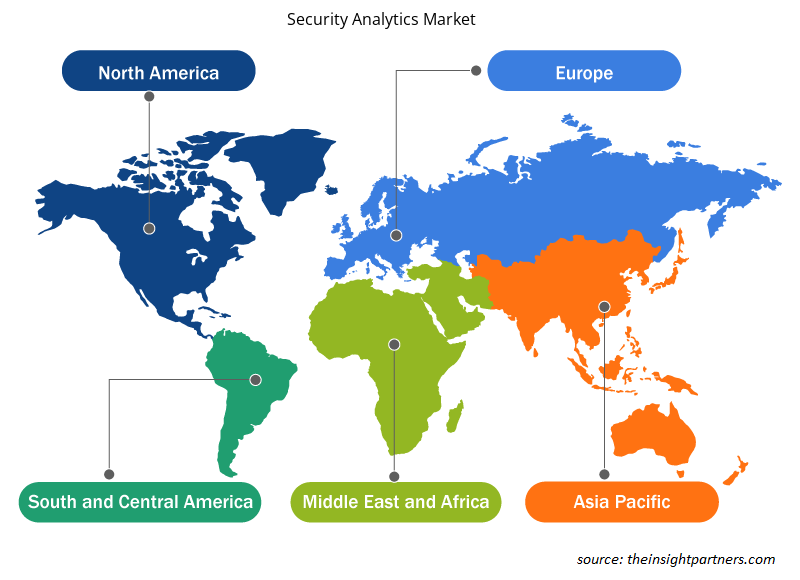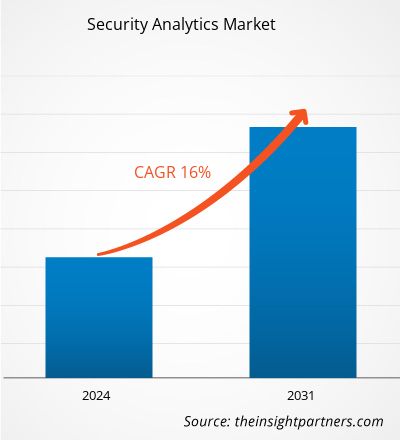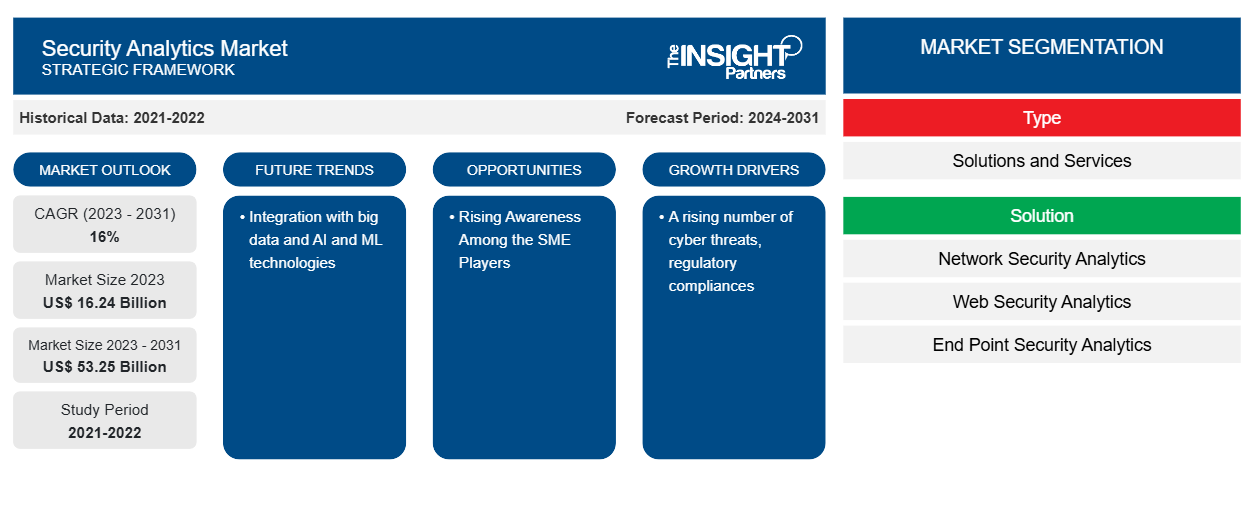安全分析市场规模预计将从 2023 年的 162.4 亿美元增至 2031 年的 532.5 亿美元。预计 2023-2031 年市场复合年增长率将达到 16.0%。大数据与人工智能和机器学习技术的融合可能仍是市场的主要趋势。
安全分析市场分析
随着网络不断变化和安全威胁变得越来越复杂,安全分析对于维护企业安全变得越来越重要。安全分析通过融合软件、算法和分析程序,帮助 IT 和安全团队在威胁导致数据丢失或其他负面后果之前主动(和被动)识别威胁。
安全分析市场概览
机器学习、行为分析和定制是当今安全分析技术进步的主要推动力。现在,多个 SIEM 软件包不再要求用户使用专有数据湖,而是允许企业使用其现有数据湖。此外,一些解决方案已公开提供其机器学习、丰富和分析模型,以便客户能够更好地理解并根据需要进行调整。为了以更自动化和遥测丰富的方式应对威胁检测和响应,业界开始整合 SIEM、用户实体行为分析 (UEBA)、安全编排、自动化和响应 (SOAR) 以及扩展检测和响应 (XDR)。近年来,安全分析发展迅速。
定制此报告以满足您的需求
您可以免费定制任何报告,包括本报告的部分内容、国家级分析、Excel 数据包,以及为初创企业和大学提供优惠和折扣
-
获取此报告的关键市场趋势。这个免费样品将包括数据分析,从市场趋势到估计和预测。
安全分析市场驱动因素和机遇
网络威胁不断上升利好市场
安全分析能够利用尖端技术检测潜在威胁、揭示隐藏的漏洞并为组织提供洞察力,使其能够加强防御并主动降低风险,因此已成为持续打击网络犯罪分子的不可或缺的工具。根据 Check Point Software Technologies Ltd. 2024 年的报告,2023 年网络威胁稳步增加。每周,全球平均有 1158 起针对企业的网络攻击。这表明数字威胁形势呈现出一致且令人担忧的趋势,网络攻击比2022 年增加了 1%,并保持了前几年的显着增长。这推动了安全分析市场的发展。
中小企业意识不断增强
CyberPeace Foundation 的一项调查显示,43% 的网络攻击针对的是初创公司和小公司。此外,大约 46% 的中小企业缺乏数字领域风险管理知识。网络威胁是一种真正的威胁,而且其运作方式也越来越复杂。虽然大多数大型、成熟的组织都采取了适当的安全措施来抵御恶意软件和数据泄露等危险,但小型企业由于资源有限,更容易受到网络安全风险的威胁。因此,这为中小企业采用安全分析工具提供了机会。
安全分析市场报告细分分析
有助于得出安全分析市场分析的关键部分是类型、解决方案、部署和行业垂直。
- 根据类型,安全分析市场分为解决方案和服务。解决方案部分在 2023 年占据最大份额。
- 根据解决方案,市场分为网络安全分析、Web安全分析、端点安全分析等。
- 根据部署方式,市场分为本地、云端和混合。
- 根据行业垂直,市场分为 BFSI、电信和 IT、政府和国防、消费品和零售等。
安全分析市场份额(按地区)分析
安全分析市场报告的地理范围主要分为五个地区:北美、亚太、欧洲、中东和非洲、南美和中美。
2023 年,北美占据了安全分析市场的很大份额。北美是全球受网络攻击影响最严重的地区之一。这是因为北美拥有大量的金融部门、重要的基础设施和公共部门伙伴关系等共享机会,所有这些都有助于建立更强大的网络生态系统。地区政府专注于加强立法和政策,以应对本国的网络风险。这推动了该地区对安全分析市场的需求。
安全分析市场区域洞察
Insight Partners 的分析师已详细解释了预测期内影响安全分析市场的区域趋势和因素。本节还讨论了北美、欧洲、亚太地区、中东和非洲以及南美和中美洲的安全分析市场细分和地理位置。

- 获取安全分析市场的区域特定数据
安全分析市场报告范围
| 报告属性 | 细节 |
|---|---|
| 2023 年的市场规模 | 162.4亿美元 |
| 2031 年市场规模 | 532.5亿美元 |
| 全球复合年增长率(2023 - 2031) | 16% |
| 史料 | 2021-2022 |
| 预测期 | 2024-2031 |
| 涵盖的领域 |
按类型
|
| 覆盖地区和国家 |
北美
|
| 市场领导者和主要公司简介 |
|
安全分析市场参与者密度:了解其对业务动态的影响
安全分析市场正在快速增长,这得益于终端用户需求的不断增长,而这些需求又源于消费者偏好的不断变化、技术进步以及对产品优势的认识不断提高等因素。随着需求的增加,企业正在扩大其产品范围,进行创新以满足消费者的需求,并利用新兴趋势,从而进一步推动市场增长。
市场参与者密度是指在特定市场或行业内运营的企业或公司的分布情况。它表明在给定市场空间中,相对于其规模或总市场价值,有多少竞争对手(市场参与者)存在。
在安全分析市场运营的主要公司有:
- IBM 公司
- 惠普企业发展有限公司 (HPE)
- 思科系统公司
- 博通公司
- 迈克菲有限责任公司
- Splunk 公司
免责声明:上面列出的公司没有按照任何特定顺序排列。

- 获取安全分析市场顶级关键参与者概览
安全分析市场新闻和最新发展
安全分析市场通过收集一手和二手研究后的定性和定量数据进行评估,其中包括重要的公司出版物、协会数据和数据库。以下列出了安全分析市场的一些发展情况:
- IBM (NYSE: IBM) 今天宣布其旗舰产品 IBM QRadar SIEM 进行了重大改进:基于新的云原生架构进行了重新设计,专为混合云规模、速度和灵活性而构建。IBM 还公布了在其威胁检测和响应产品组合中提供生成式 AI 功能的计划——利用该公司的企业级数据和 AI 平台 Watsonx。(来源:IBM,新闻稿,2023 年 11 月)
- 博通公司 (NASDAQ: AVGO) 旗下子公司赛门铁克正在与 Google Cloud 合作,分阶段将生成式人工智能 (gen AI) 嵌入赛门铁克安全平台,这将为客户提供检测、理解和补救复杂网络攻击的重大技术优势。(来源:博通公司,新闻稿,2023 年 9 月)
安全分析市场报告覆盖范围和交付成果
“安全分析市场规模和预测(2021-2031)”报告对市场进行了详细分析,涵盖以下领域:
- 安全分析市场规模以及全球、区域和国家层面涵盖的所有主要细分市场的预测
- 安全分析市场趋势以及市场动态,例如驱动因素、限制因素和关键机遇
- 详细的 PEST/波特五力分析和 SWOT 分析
- 安全分析市场分析涵盖主要市场趋势、全球和区域框架、主要参与者、法规和最新市场发展
- 行业格局和竞争分析,涵盖市场集中度、热图分析、知名参与者以及安全分析市场的最新发展
- 详细的公司简介
- 历史分析(2 年)、基准年、预测(7 年)及复合年增长率
- PEST和SWOT分析
- 市场规模、价值/数量 - 全球、区域、国家
- 行业和竞争格局
- Excel 数据集
近期报告
相关报告
客户评价
购买理由
- 明智的决策
- 了解市场动态
- 竞争分析
- 客户洞察
- 市场预测
- 风险规避
- 战略规划
- 投资论证
- 识别新兴市场
- 优化营销策略
- 提升运营效率
- 顺应监管趋势























 获取免费样品 - 安全分析市场
获取免费样品 - 安全分析市场